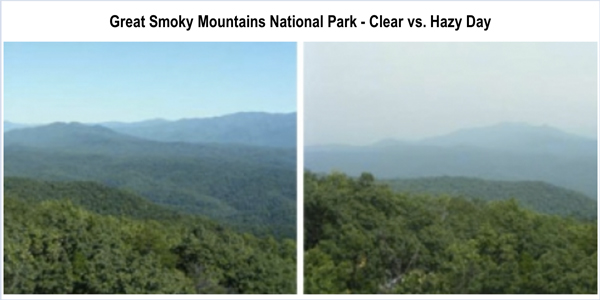By Michael Kuser
The D.C. Circuit Court of Appeals on Tuesday denied several petitions for review of final EPA action on steps to cut pollution from electric power plants in order to restore to “natural conditions” the air quality and visibility in “Class I” national parks and wilderness areas.
EPA, under the 2012 Clean Air Act, issued its Regional Haze Rule, which revised its guidelines on Best Available Retrofit Technology (BART) for stationary pollution sources, usually power plants, installed before August 1977. The new rule also specified that the agency’s 2011 Cross-State Air Pollution Rule (CSAPR) had requirements stringent and effective enough for it to serve as a better-than-BART alternative for states participating in CSAPR, thus excusing states from compliance with BART itself.
EPA also disapproved portions of certain State Implementation Plans (SIPs), designed to achieve reasonable progress under the Regional Haze Rule because those plans relied on a soon-to-be-defunct predecessor of CSAPR, the Clean Air Interstate Rule (CAIR).
The National Parks Conservation Association and the Sierra Club challenged allowing states to treat CSAPR compliance as a better-than-BART alternative.
Multiple power companies and the Utility Air Regulatory Group, as well as the State of Texas and the Louisiana Department of Environmental Quality, challenged EPA’s disapproval of SIPs relying on CAIR as a better-than-BART alternative.
“Except to the extent that the challenges are moot, we affirm EPA’s actions,” said the March 20 opinion by D.C. Circuit Court of Appeals Senior Circuit Judge Stephen F. Williams.
The three-judge panel consisted of Thomas B. Griffith and Cornelia T.L. Pillard, circuit judges, and Senior Circuit Judge Williams.
Useful Life
Dealing with the conservationists’ petition first, the opinion said that “the attack on EPA’s use of presumptive BART … is jurisdictionally foreclosed by the 60-day filing window provided by the Clean Air Act.”
Furthermore, Judge Williams described “a cavalcade of attacks on alleged modelling errors,” wherein “the conservation petitioners fix on a comment that EPA failed to address in its response to comments, specifically an assertion that EPA’s model does not take into account the remaining ‘useful life’ of specific BART-eligible sources.”
The agency did not contest that it overlooked these comments.
“It argues now — reasonably, in our view — that the effects of a plant’s useful life are too speculative to model, and not significant enough to make any modeling a useful enterprise,” said the opinion. “We see no need to remand on this point for EPA to move this bit of post-hoc rationalization into a rulemaking record.”
The conservation petitioners finally argued that, in comparing CSAPR and BART, EPA compared the wrong averages.
The court disagreed, referring to its reasoning in an earlier petition from the Utility Air Regulatory Group.
“It is in the nature of averages that some particular sites may underperform while others overperform,” said the decision. “EPA’s rule requires aggregate average improvement, and its comparison of the CSAPR-region Class I areas as well as all Class I areas nationwide was reasonable.”
State and Industry
The state and industry petitioners in essence argued that if compliance with CAIR had for years allowed them to achieve greater reasonable progress than BART would have, their continued enforcement of emissions standards in line with the now-defunct CAIR must necessarily be found an adequate alternative to BART.
“But, of course, without CAIR — which all parties agree is dead and beyond revival — there is no legal basis for a requirement that states control their sources at CAIR levels; indeed, for states that are not part of CSAPR, there is no legal basis for requiring states to participate in any haze-related interstate trading program,” said the court.
The court cannot order EPA to consider CAIR an alternative to BART without resurrecting CAIR itself, “a rule that we have already stricken and ordered to be vacated,” said the decision.
The petitioners saved themselves from mootness only by couching their request for relief as “a contingency,” said the opinion. The court denied the state and industry petitioners, saying they “can afford no relief.”





